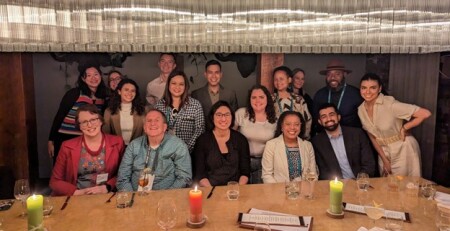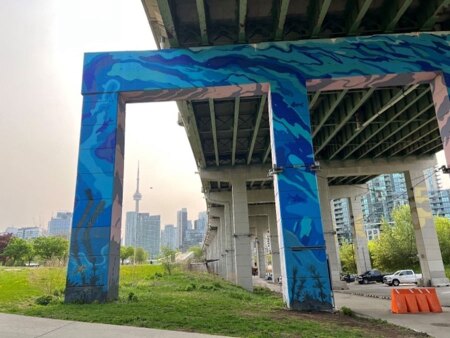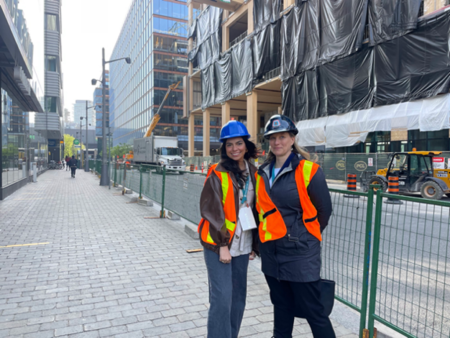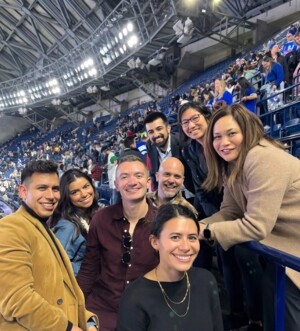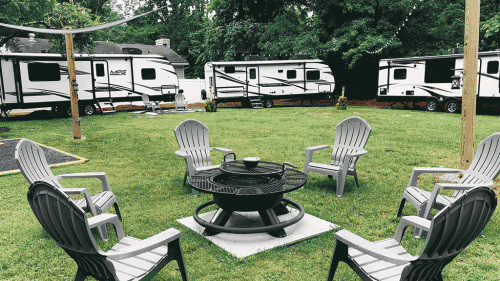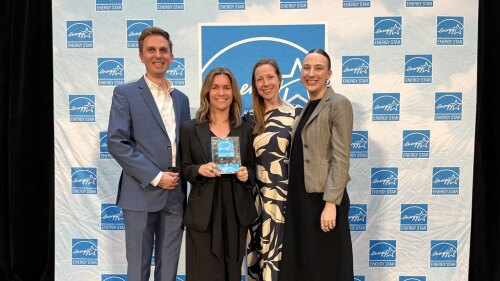ULI Building Healthy Places brought together the sixth cohort of the ULI/Randall Lewis Health Mentorship Program at the 2023 Spring Meeting for three days of learning, network building, and exchange. Since 2017, the program has matched graduate students with ULI members working at the intersection of health and the built environment to learn about ULI and deepen their understanding of opportunities to advance health outcomes through careers in land use, planning, and real estate.
This year’s Spring Meeting backdrop of Toronto, a metro region experiencing high rates of growth and development, provided ample opportunities to explore challenges and opportunities facing real estate in Canada’s largest city. While Toronto has cut its greenhouse gas emissions by 43 percent from 1990 to 2020 and serves as a vibrant hub and home to over 250 different ethnic groups, the city, like many others in North America, grapples with a housing crisis, sprawling development, and an aging population. This raises a crucial question: How can the city and private-sector stakeholders support communities and develop in ways that enhance individual and community health and well-being?
Alongside their cohort peers and mentors, health mentees spent the week connecting their graduate coursework to projects, places, and people in Toronto working to make real estate a critical promoter of health. Here, the health mentees share reflections from their Spring Meeting experiences.
Tell us about your most significant takeaway from the Spring Meeting.
Oche Bridgeford: “While I arrived at the ULI Spring Meeting with audacious goals in mind, my conversations with seasoned ULI members encouraged me to dream bigger and more specifically. One individual who left a lasting impression was my mentor, Anyeley Hallová. She stands at the forefront of green building practices yet carries her award-winning work with remarkable humility and a genuine openness to learn from others. Her commitment to building healthy environments and creating spaces that invite others to participate in this work exemplifies the kind of impact-driven professional I aspire to become. Connecting with Anyeley and witnessing her dedication further solidified my belief in the potential for real estate to contribute to positive social and environmental change.”
Jessica Tang: “My biggest takeaway is that a, if not the, central question behind ensuring that developments support health and social equity is asking who the three sectors (private, public, and nonprofit) are designing and building for, where these answers converge and diverge, and what kinds of values the built environment can help manifest in the long term for the communities it will serve (thinking a lot about this index from the Just City Lab). Another takeaway is that I still have a lot to learn!”
What was the most impactful session that you participated in and why?
Danielle Paulazzo: “During product council day, we toured the Regent Park Community, which had recently been redesigned from an entirely low-income housing development to a mixed-income and mixed-use community. We heard perspectives from the builder, Toronto’s low-income housing authority (Toronto Community Housing), and from a tenant who had lived in the community before and after the redevelopment. Hearing from all three perspectives was a great real-world example of meaningful stakeholder engagement and a demonstration of how important it is to maintain channels of communication and feedback throughout all stages of a project. While not perfect, the tenant reported that the project had brought significant improvements to her daily life. However, she also shared ongoing concerns she has raised, and it was heartening to see a representative of Toronto Community Housing engaged in these conversations and bringing this tenant and her critiques to the presentation for our council. With this approach, the project team was able to design a project that was financially sustainable while balancing the quality-of-life concerns that tenants deserved to have addressed.”
Sarah Carrillo: “For me, the most impactful sessions were the ones associated with the Sustainability Development Product Council. My mentor, Marja Williams, invited me as her guest for the dinner, and upon guest introductions, I was the only student in the room. This was a huge moment for me and an honor to represent the ULI/Randall Lewis Health Mentorship Program. Having the opportunity to speak with leaders and professionals in the industry was invaluable. During the product council day, we put hard hats on and went to tour George Brown College’s Limberlost project. After learning about the site through a presentation and renderings, it was incredible to see the physical process and what it takes to create a sustainable mass timber development, and I was able to connect the two to gain a more comprehensive understanding of the dedication and forward-thinking [that] industry leaders possess to create a site like Limberlost.”
How did the Spring Meeting in Toronto make you think differently about health and social equity in real estate?
Yasir Alfarag: “The Spring Meeting emphasized the importance of making new developments environmentally friendly by focusing on decarbonization and promoting transportation options that prioritize health, like walking or biking. I learned that real estate can play a role in addressing the effects of institutionalized racism by creating more opportunities for homeownership. ULI is dedicated to advancing social equity through various initiatives, such as the Homeless to Housed program. ULI also conducts research on how zoning can be made more equitable and sustainable. Attending the meeting shifted my perspective on the role of real estate development in tackling climate change. Prior, I had limited knowledge about the strategies employed by developers to address this global challenge. However, through the meeting, I gained insights into the various methods and approaches used by developers in this regard. Additionally, I came to appreciate the significance of integrating placemaking initiatives into real estate development. It became evident to me that by incorporating these initiatives, we can enhance the unique character of places and foster creativity within local communities. This newfound understanding has broadened my outlook on the potential of real estate development to contribute positively to environmental sustainability and community enrichment.”
Jude Hernandez: “Spring Meeting in Toronto was a reaffirmation of the positive impact real estate can have on health and people through the built environment. Through the various tours and sessions made available this spring, I experienced firsthand how placemaking truly is a community effort, and rarely is it easy. Toronto, just like many other cities in the U.S., grapples daily with the decisions of the past. Yet it was amazing to see how organizations like the Bentway transformed what was otherwise un-utilized land under an above-grade highway into a multifaceted public space. Informed through community engagement, the space below the Gardiner Express[way] is alive and growing. A highway structure that traditionally bisects communities is now a thriving green space that all can enjoy below it. Being able to witness the positive changes that unused spaces can undergo is a pleasant reminder that we do not always have to reinvent the wheel. Oftentimes, the best way to improve health and equity in the built environment is by adapting the spaces right in front of us.”
To learn more about the Health Mentorship Program, visit uli.org/healthmentors. To learn more about ULI Building Healthy Places and for ways to get involved, visit uli.org/health.

